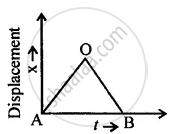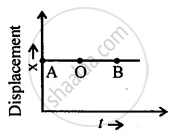Advertisements
Advertisements
प्रश्न
Write down the type of motion of a body along with the A – O – B of the following distance – time graph.

उत्तर
From A to O, the body is in uniform motion having a positive slope and from O to B, the body is in uniform motion having a negative slope.
APPEARS IN
संबंधित प्रश्न
Under what condition(s) is the magnitude of average velocity of an object equal to its average speed?
Change the speed of 6 m/s into km/h.
Arrange the following speed in increasing order (keeping the least speed first):
An athlete running with a speed of 10 m/s.
A car is moving along a straight road at a steady speed. It travels 150 m in 5 seconds:
How long does it take to travel 240 m ?
A car is moving on a straight road with uniform acceleration. The speed of the car varies with time as follows :
Time (s) : 0 2 4 6 8 10
Speed (m/s) : 4 8 12 16 20 24
Draw the speed-time graph by choosing a convenient scale. From this graph :

(1) Calculate the acceleration of the car.
(2) Calculate the distance travelled by the car in 10 seconds.
The graph given alongside shows how the speed of a car changes with time:

(i) What is the initial speed of the car ?
(ii) What is the maximum speed attained by the car ?
(iii) Which part of the graph shows zero acceleration ?
(iv) Which part of the graph shows varying retardation ?
(v) Find the distance travelled in first 8 hours.
Which of the following can sometimes be 'zero' for a moving body?
(i) average velocity
(ii) distance travelled
(iii) average speed
(iv) displacement
The diagram below shows the pattern of the oil on the road at a constant rate from a moving car. What information do you get from it about the motion of the car.

From the displacement-time graph of a cyclist given below in the Figure, find The average velocity in the first 4 s.

Write down the type of motion of a body along with the A – O – B of the following distance – time graph.

